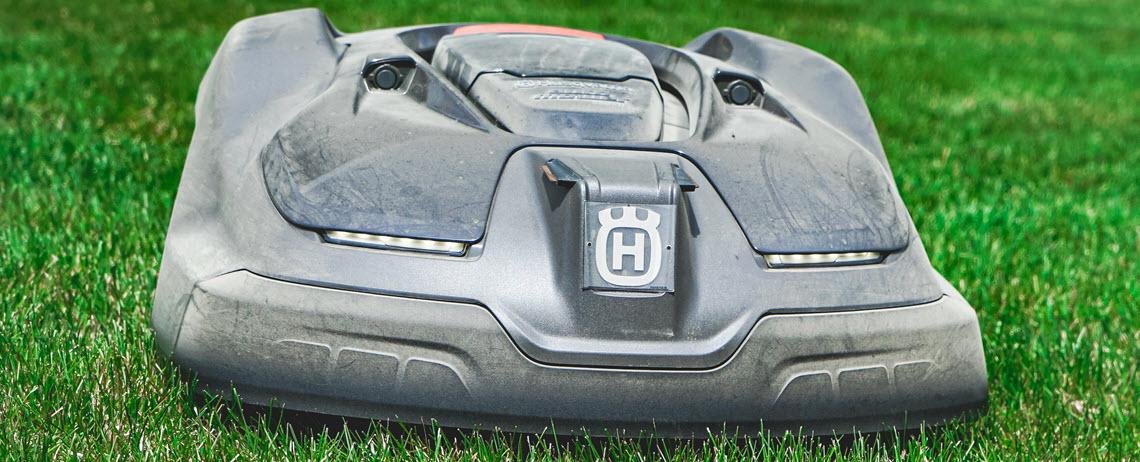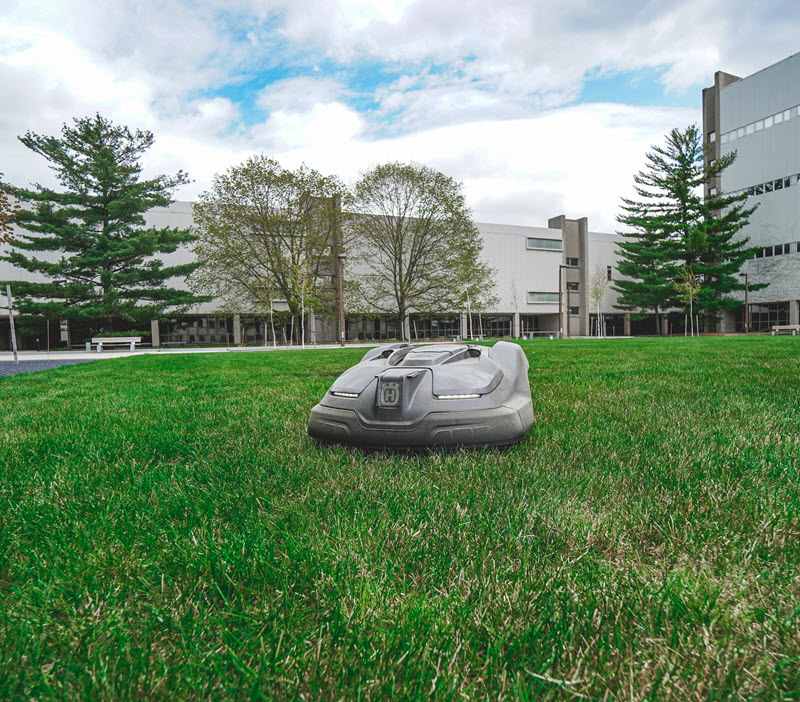Innovative landscaping practices promote sustainability

Anthony Yuhasz
May 19, 2020
As thoughtful stewards of MSU’s resources, the IPF Landscape Services team continuously looks for new technologies that can help improve efficiency while keeping the campus environment looking beautiful, healthy and safe.
“It is our commitment to the university and community to provide the highest level of service while supporting and growing this living, learning laboratory,” said Jeremiah Saier, Landscape Services GIS planner/inspector/analyst. “There is a fantastic opportunity right now to exercise how efficient and relevant we can be during tough times – embracing the challenge and leading by example.”
He added, “Changing the way we do our jobs is motivating, contagious and energizing – all things we need right now.”
We spoke with Saier and Landscape Services manager, Matt Bailey about their employment of autonomous mowers at the Interdisciplinary Science and Technology Building (ISTB) and Cowles House.
What is the overall goal of this initiative?
Saier: “To provide the most efficient, sustainable service to the university while better meeting our customer needs and reducing associated cost.”
What should employees who might be concerned about these autonomous mowers eliminating jobs know about them?
Saier: “We are creating opportunities for our skilled staff to concentrate their efforts where human interaction and decision-making capabilities are required. While mowing turf is a critical piece of our efforts, it is time intensive and can become repetitive. It is the perfectly suited task for an automated machine, where our quality standards can still be met.”
What were the deciding factors that resulted in you adopting the Husqvarna autonomous mower model that you are now using at ISTB?
Saier: “Husqvarna has been in the autonomous residential space for almost two decades in Europe. More recently, they started offering commercial solutions at a very attractive price point. Now is the time for us to move from testing robotic mowers to relying on them as a part of our fleet. The high level of reliability and local vendor customer service made our decision relatively easy. We will eventually deploy the same type of unit at Cowles House.”

How is the unit operated?
Saier: “The mower operates by continuously clipping just a little grass at a time, staying ahead of growth while naturally fertilizing the turf. There is a small copper wire buried just under the surface that bounds the robot to its mowing space, and a housing station for charging.”
What safety features are employed on the mowers?
Saier: “Once an obstacle is detected, the mower slows to half-speed before making contact, then pivots to a clear exit path. The cutting head is recessed on the underside of the machine making it nearly impossible to reach while spinning. The robot has lift sensors and a large STOP button located on the top portion. The unit can only be restarted after a human-interaction fault by physically entering a passcode on the device. All operation can be monitored and controlled remotely on a mobile application. The unit is GPS equipped to protect against theft and/or vandalism.”
Jeremiah Saier, Landscape ServicesIt is our commitment to the university and community to provide the highest level of service while supporting and growing this living, learning laboratory. There is a fantastic opportunity right now to exercise how efficient and relevant we can be during tough times – embracing the challenge and leading by example.
How often does it mow the area?
Saier: “The mower is currently operating 24/7. We do have the ability to create a daily schedule with flexible mow times around peak human activity, events and irrigation, if necessary.”
Does the mower provide the same level of cut quality as the traditional riding mower?
Saier: “In my opinion, better. The mower is designed to cut such a small amount of grass (1/8 inch) per pass that the clippings produced act as a natural fertilizer and encourage a healthier thatch layer, which provides better germination and higher moisture retention.”
Are there any other benefits in using this mower over the traditional riding mower?
Saier: “Noise reduction, zero emissions, randomized patterning and the elimination of tracking from heavier machinery.”
Bailey: “We have programmed the mower to mow 6” outside of the barrier wire so that we don’t have to trim. So far, we have not had to weed whip or blower sweep this lawn panel.”
What is your best estimate of the cost savings resulting in employing these units?
Saier: “Using our Landscape Management Plan estimator, we predict roughly 8-9 months of utilization (1.5 growing seasons) will meet our full ROI (Return on Investment) potential. Once we’ve hit our ROI goal, we’ll save the university approximately $2,100 per season at the ISTB courtyard alone, for a much nicer, environmentally-friendly space.”
We understand that not only are the mowers improving efficiency, but the vendor is also working with us in how we can design green spaces to maximize their abilities. How is that working?
Bailey: “We are working with Husqvarna to develop a design handbook that can be utilized when designing new spaces or renovating existing ones. Some of the suggested considerations include creating rounded bed lines; reducing 90-degree angles in beds where the mowers cannot fit; identifying power sources, copper wire layout and homing wire location for charging; and incorporating “doggy doors” cut into fenced areas that would allow the mower to do both front and back yards.”
What is the plan for the Mow-Bot unit that was tested last year?
Saier: “Mow-Bot is currently being operated on Munn field and likely will remain at one of the I.M. Sports fields throughout this growing season. Risk Management has agreed to allow full-autonomous operation in a fenced corridor with proper signage indicating the robot’s presence. The Covid-19 pandemic has altered campus activities greatly – with far less people traveling our campus this summer we have a unique opportunity to test these autonomous vehicles in real-world conditions with relatively low risks.”
What does this mean, personally and professionally, for the Landscape Services team?
Saier: “It’s good to know we’re embracing this relatively new technology now. This industry moves very fast and if you are not agile and willing to adapt, you will be left behind. This autonomous initiative provides our staff the ability to better focus their efforts on more detailed tasks and expand their responsibilities.”
